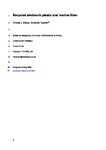Recycled electronic plastic and marine litter
| dc.contributor.author | Shaw, EJ | |
| dc.contributor.author | Turner, Andrew | |
| dc.date.accessioned | 2019-08-30T15:12:18Z | |
| dc.date.available | 2019-08-30T15:12:18Z | |
| dc.date.issued | 2019-12-01 | |
| dc.identifier.issn | 0048-9697 | |
| dc.identifier.issn | 1879-1026 | |
| dc.identifier.other | 133644 | |
| dc.identifier.uri | http://hdl.handle.net/10026.1/14832 | |
| dc.description.abstract |
Black consumer plastics are often contaminated with hazardous chemicals because of technological constraints on sorting dark plastic during recycling of municipal waste coupled with the convenience of waste electrical and electronic equipment (WEEE) as a secondary source of black plastic. In this study, samples of beached plastic litter (n = 524) from southwest England were categorised according to origin, appearance and colour (black versus non-black) before being analysed by x-ray fluorescence (XRF) spectrometry for elements that are characteristic of EEE. The small number of items of WEEE retrieved (n = 36) were largely restricted to wiring insulation and constructed of lead-stabilised polyvinyl chloride (PVC). Among the remaining samples, Br, Cd, Cr and Pb were commonly detected in all categories of black plastics (n = 264) with maximum concentrations of 43,400 mg kg-1, 2080 mg kg-1, 662 mg kg-1 and 23,800 mg kg-1, respectively. Moreover, concentrations of Br were significantly correlated with concentrations of the flame retardant synergist, Sb (n = 22), and 35 samples were potentially non-compliant with regard to limits defined by the Restriction of Hazardous Substances Directive. For plastics of other colours (n = 224), Br and Pb were detected in fewer samples and Br was co-associated with Sb in only two cases, with occasional high concentrations Cd, Cr and Pb largely attributed to the historical use of cadmium sulphide and lead chromate pigments. An avian physiologically-based extraction test applied to selected samples cut to mm-dimensions revealed bioaccessibilities ranging from <0.1% for Cr in a green fragment to about 2.4% (or about 580 mg kg-1) for Pb in black PVC. The recycling of WEEE into consumer, industrial and marine (e.g. fishing) plastics that are mainly coloured black appears to be an important vehicle for the introduction of hazardous chemicals into the environment and a source of their exposure to wildlife. | |
| dc.format.extent | 133644-133644 | |
| dc.format.medium | Print-Electronic | |
| dc.language | en | |
| dc.language.iso | en | |
| dc.publisher | Elsevier | |
| dc.rights | Attribution-NonCommercial-ShareAlike 4.0 International | |
| dc.rights | Attribution-NonCommercial-ShareAlike 4.0 International | |
| dc.rights | Attribution-NonCommercial-ShareAlike 4.0 International | |
| dc.rights | Attribution-NonCommercial-ShareAlike 4.0 International | |
| dc.rights | Attribution-NonCommercial-ShareAlike 4.0 International | |
| dc.rights.uri | http://creativecommons.org/licenses/by-nc-sa/4.0/ | |
| dc.rights.uri | http://creativecommons.org/licenses/by-nc-sa/4.0/ | |
| dc.rights.uri | http://creativecommons.org/licenses/by-nc-sa/4.0/ | |
| dc.rights.uri | http://creativecommons.org/licenses/by-nc-sa/4.0/ | |
| dc.rights.uri | http://creativecommons.org/licenses/by-nc-sa/4.0/ | |
| dc.subject | Electrical and electronic | |
| dc.subject | Marine plastic | |
| dc.subject | Bromine | |
| dc.subject | Heavy metals | |
| dc.subject | Recycling | |
| dc.subject | Exposure | |
| dc.title | Recycled electronic plastic and marine litter | |
| dc.type | journal-article | |
| dc.type | Journal Article | |
| plymouth.author-url | https://www.webofscience.com/api/gateway?GWVersion=2&SrcApp=PARTNER_APP&SrcAuth=LinksAMR&KeyUT=WOS:000496780900067&DestLinkType=FullRecord&DestApp=ALL_WOS&UsrCustomerID=11bb513d99f797142bcfeffcc58ea008 | |
| plymouth.volume | 694 | |
| plymouth.publication-status | Published | |
| plymouth.journal | Science of the Total Environment | |
| dc.identifier.doi | 10.1016/j.scitotenv.2019.133644 | |
| plymouth.organisational-group | /Plymouth | |
| plymouth.organisational-group | /Plymouth/Faculty of Science and Engineering | |
| plymouth.organisational-group | /Plymouth/Faculty of Science and Engineering/School of Geography, Earth and Environmental Sciences | |
| plymouth.organisational-group | /Plymouth/REF 2021 Researchers by UoA | |
| plymouth.organisational-group | /Plymouth/REF 2021 Researchers by UoA/UoA07 Earth Systems and Environmental Sciences | |
| plymouth.organisational-group | /Plymouth/Research Groups | |
| plymouth.organisational-group | /Plymouth/Research Groups/BEACh | |
| plymouth.organisational-group | /Plymouth/Research Groups/Marine Institute | |
| plymouth.organisational-group | /Plymouth/Users by role | |
| plymouth.organisational-group | /Plymouth/Users by role/Academics | |
| dc.publisher.place | Netherlands | |
| dcterms.dateAccepted | 2019-07-26 | |
| dc.rights.embargodate | 2020-7-31 | |
| dc.identifier.eissn | 1879-1026 | |
| dc.rights.embargoperiod | Not known | |
| rioxxterms.version | Accepted Manuscript | |
| rioxxterms.versionofrecord | 10.1016/j.scitotenv.2019.133644 | |
| rioxxterms.licenseref.uri | http://creativecommons.org/licenses/by-nc-sa/4.0/ | |
| rioxxterms.licenseref.startdate | 2019-12-01 | |
| rioxxterms.type | Journal Article/Review |



